ISSN ONLINE(2278-8875) PRINT (2320-3765)
ISSN ONLINE(2278-8875) PRINT (2320-3765)
S.Rathinamala1, Dr.S.Manoharan2
|
| Related article at Pubmed, Scholar Google |
Visit for more related articles at International Journal of Advanced Research in Electrical, Electronics and Instrumentation Engineering
This paper presents a survey on vibration powered generators and power processing circuits for energy harvesting. Vibration powered microgenerator, which harvest mechanical energy from environment and convert this energy into useful electrical power. This survey starts by introducing micro - energy harvesters and their use, it is then explained the way these devices obtain energy from the environment. Different microgenerators that will obtain the energy from vibrations are presented. This paper is focused on using the principle of electromagnetic induction for the generation of electrical power from low frequency vibration in the environment. And also a number of suitable converter topologies for low voltage, low power energy harvestings are presented. Significant challenges in converting the power and novel converter topologies for low voltage microgenerators are also highlighted in this paper. Multiple methods to interface the microgenerator with the converters are presented.
Keywords |
| Vibration powered micro generator, AC-DC Boost converter,energy harvesting, low power, lowvoltage, Power converter circuit. |
INTRODUCTION |
| Energy harvesting from solar, wind, vibrations, thermal, etc. to power wireless devices has been attracting considerable interest in the past few years [1]. While solar Energy provides relatively higher energy density outdoors, its efficiency under indoor conditions is considerably lower. Similarly, Thermal devices require a temperature gradient in order to generate electrical energy and this is difficult to achieve over the small distances available in miniature generators. Consequently, this paper is concerned with motion -driven micro-generators, which generate electrical energy from a source of kinetic energy, usually a vibration. A vibration Energy harvesting using piezoelectric and electromagnetic and electrostatic generators require high excitation energy to provide reasonable power levels. The real challenge is making this process feasible and efficient enough to replace batteries. Micro systems that are able to convert energy present in their environment are one of the key components to self-powered system for critical environment. [2] |
| In the field of low power generation, Vibration-driven generators were very attractive due to the availability of the vibration energy in the environment. Most current techniques that attempt to increase the output of these energy generators require substantial compromises in implementation. There are significant challenges in converting the power generated from such devices to useable form, particularly in micro-engineered variants. This paper examines this power conversion requirement for each of the cases of Vibration-driven generators, and presents new circuit approaches. |
VIBRATION POWERED GENERATORS |
| Solar (light), thermal gradient, and vibration are types of environmental energies that can be harvested and converted to useful electrical energy. However, because vibration energy exists in many industrial, built, and transportation environments, this waste energy can be converted to electrical energy through three main kinds of transduction mechanisms: electromagnetic, electrostatic, and piezoelectric transduction mechanisms. All vibration energy conversion mechanisms use a linear mechanical oscillator to resonate naturally according to the excitation frequency presents in the environment. |
A. Piezoelectric generators |
| The piezoelectric generators directly convert the vibration into a voltage output by using an electroded piezoelectric material. There is no requirement for having complex geometries. However, the piezoelectric materials are required to be strained directly and therefore their mechanical properties will limit the overall performance and lifetime. Also the transduction efficiency is ultimately limited by piezoelectric properties of materials employed. The disadvantage of piezoelectric conversion is the difficulty of implementation on the micro-scale and integration with microelectronics. |
B. Electrostatic generators |
| The electrostatic generator is based on converting of ambient mechanical vibration into electricalenergy by using MEMS variable capacitor [11]. By placing charge on the capacitor plates, the voltagewill increase as the capacitance decreases. If the voltage is placed on the capacitor, charge willmove from the capacitor as the capacitance decreases. In both cases, mechanical energy isconverted into electrical energy which can be stored and utilized by a load. The major problem associated with capacitive converters is that some method must be employed to hold the voltage, across the MEMS device, constant during the conversion process, whichrequires a separate voltage source. It is also not capable of converting sufficient power per unitvolume. |
C.Electromagnetic Generator |
| Electromagnetic energy harvesters harness energy by using the surrounding vibrations to displace a magnetic mass relative to a coil. This relative movement will create a current through the coil and generate power, usually at a micro scale. Using this principle, there are many variants for an electromagnetic energy harvester as shown in Fig.1. |
| The microgenerator model consisting of a moving spring (k), rare earth permanent magnet, the mass of the spring (m) and an electrical coil represented by the dashpot (d). The magnet is attached to the spring to form the spring mass system. When the generator is vibrating the magnet will move towards the electric coil. As a result, electric power will be induced across the coil according to Faraday’s law of induction [3]. The input to the generator is the vibration displacement, y (t) and this vibration produces a movement of the mass, x (t).Finally, Electromagnetic harvesters offer more simplicity in its design and fabrication than the electrostatic or the piezoelectric solution. It is also more useful at bigger volumes and at lower frequencies. |
REVIEW ON DIFFERENT RESEARCH WORKS |
| A recent technique for generating power from vibration was presented by Glynne-jones et.al. and White et.al., [4]. A basic investigation of piezoelectrics and possible applications to micro-power generation is given in [5]. The available electrical output power is proportional to the square of the applied force and the electrical energy in the piezoelectric being proportional to that stored as strain energy. In his Ph.D. thesis [6], Kim conducts an in-depth study into the electrical power generated from different topologies of piezoelectric generator, operating in different modes, developing analytic expressions for power generation for the different configurations. |
A . Review on Electromagnetic Generator |
| A more generic patent on inertial generators, from Tiemann in 1996[7] suggest the use of a mass spring system allowing relative movement between magnets and coils to generate electricalenergy from vibration. A fundamental difference between theHayakawa's device and Tiemann's device aredescribed. In these two patents, Hayakawa's device requires a rotational acceleration as the kinetic energy input to the device, where as Tiemann's device requires a linearly reciprocating vibration. |
| Williams et.al. [8] published an analysis of the vibration-based electromagnetic microgenerator. This microgenerator has dimensions of around 5 mm × 5 mm × 1 mm. Analysis predicts that the power produced is proportional to the cube of the frequency of vibration, and that to maximize power generation the mass deflection should be as large as possible. Power generation of 1 μW at 70 Hz and 0.1 mW at 330 Hz are predicted for a typical device, assuming a deflection of 50 μm. |
| Another design of electromagnetic microgenerator is developed byJ. R. Amirtharajah et.al .[9]The generator is in a macro size and designed to work from vibrations induced by human walking, and is predicted to produce 400 μW of power from 2cm movement at frequency of 2Hz. A moving coil electromagnetic transducer was used as a power generator, 400 μW power can be generated. As they reported the measured output voltage which was 180mV, they did not report the output power. However, 180mV was still too small for their application and they needed a transformer to rectify the voltage and this one can vary both the electrical and mechanical parameters. |
| Scott Meningeret.al [10] using microelectromechanical systems (MEMS) technology, such a device has been designed for thesystem. A low-power controller IC has been fabricated in a 0.6- m CMOS process and has been tested and measured for losses. The system is to produce 8 W of usable power. In addition to the fabricated programmable controller, an ultra low-power delay locked loop (DLL)-based system capable of autonomously achieving a steady-state lock to the vibration frequency is described. |
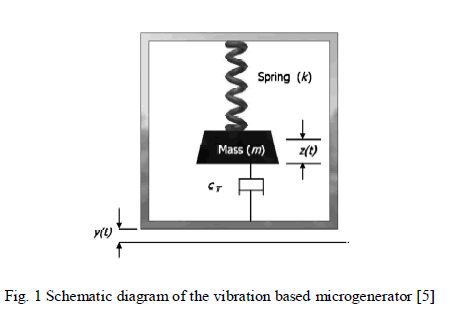 |
| P. D. Mitcheson et.al ,[11] analysis thetypes of microgenerator architectures, the relative merits of each, and in order to find optimal architectures for maximal power generation under the different operating constraints of displacement and normalized frequency.The optimization also considers physical generator constraints such as voltage limitation or maximum or minimum damping ratios. The sensitivity of each generator architecture to the source vibration frequency also analyzed. |
| According to P.Glynne-Jones et.al. [4], two configurations as shown in Fig. 2 were studied. The first configuration consists of two magnets, Fig. 2(a) while the second configuration, Fig 2(b) consists of four magnets [4]. Neodymium Iron Boron magnet was used in his design. First configuration electromagnetic generator is capable of producing useful level of power, however the output voltage is considered too low for practical application. Meanwhile, the second configuration is able to generating useful power and voltage levels from ambient vibrations. |
| Chitta Ranjan Saha et.al [12] presents the modelling and optimization of an electromagnetic-based generator for generating power from ambient vibrations. Basic equations describing such generators are presented and the conditions for maximum power generation are described. Two-centimetre scale prototype generators, which consist of magnets suspended on a beam vibrating relative to a coil, have been built and tested. |
| S P Beeby et.al[13], designed a small (component volume 0.1cm3, practical volume 0.15cm3) electromagneticgenerator utilizing discrete components and optimized for a low ambient vibration. The generator uses four magnets arranged on an etched cantilever with a wound coil located within the moving magnetic field. Magnet size and coil properties were optimized, with the final device producing 46 μW in a resistive load of 4 kΩfrom just 0.59 m s−2 acceleration levels at its resonant frequency of 52 Hz. A voltage of 428 mVrms was obtained from the generator with a 2300 turn coil which has proved sufficient for subsequent rectification and voltage step-up circuitry. The generator delivers 30% of the power supplied from the environment to useful electrical power in the load. |
| Lun-De Liao et al. [14]presented a design, analysis and experiment of a miniaturized rotary generator in size of 10 times 10 times 2 mm3 and its compact energy harvest circuit chip. The designed generator consists of patterned planar copper coils and a multipolar hard magnet ring made of NdFeB. The optimized generator offers 4.5 V and 7.23 mW in root mean square (rms) at 10 000 r/min. |
| PaulC.-P et.al[15] presented a synthesis of a new energy harvest system that consists of a hula-hoop transformer, amicro-generator and an interface energy harvest circuit. The hula-hoop transformer mainly comprises a main masssprung in one translational direction and a free-moving mass attached at one end of a rod, the other end of which is hinged onto the main mass. The transformer is capable of transforming linear reciprocating motions to rotary ones based on the concepts similar to the hula hoop motions. The transformer is subsequently integrated with a miniaturized rotarygenerator in size of 10 x10 x 2 mm3 and its compactenergy harvest circuit chip. The designed generator consists of patterned planar copper coils and a multi-polar hard magnet ring made of NdFeB. The genetic algorithm (GA) is applied to optimize the critical dimensions of theminiaturized generator. The optimized generator offers 4.5volt and 7.23 mW. |
| Zuraini Dahari et.al [16] presented a comparative study of electromagnetic generator via Finite Element Analysis (FEA). Investigations on magnetic behaviours of different configurations of electromagnetic generators are conducted via FEA. An average power of 157 μW is obtained when a similar device described mounted on the engine block of a car. And the author investigated different configurations of electromagnetic generator via FEA. It involves the investigation of the magnetic behaviours for several configurations of electromagnetic generator. Finite element models are developed and further analysed via ANSYS software. |
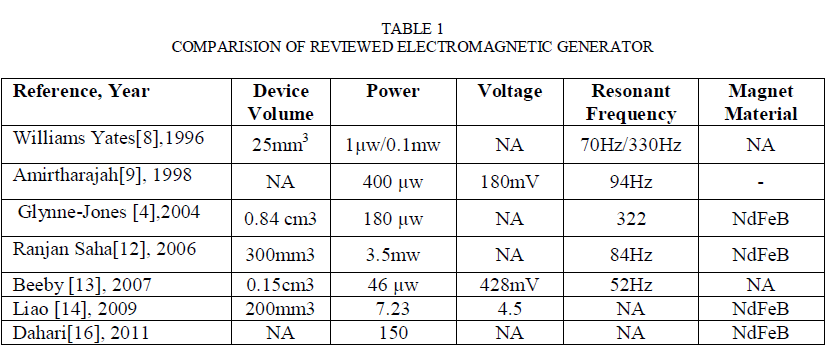 |
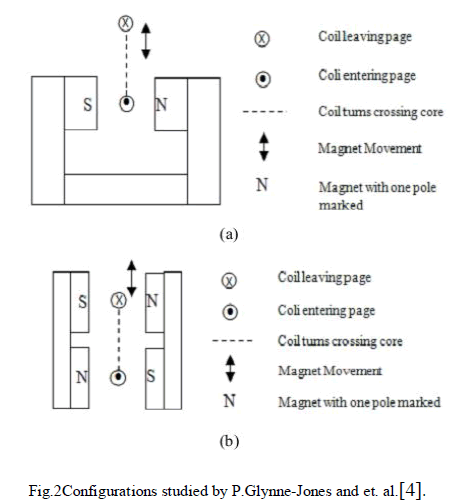 |
| The reviewed researches are summarized in Table 1. Based on the literature review, cantilever spring or spiral spring are commonlyused in designing microgenerator. Majority of the reported works utilized Neodymium Iron Born(NdFeB) in their design. Winding coils or electroplated coils are used for designing [2]. The future research trends are to developing a smaller size and wide bandwidth of resonant frequency of the electromagnetic micro power generator. |
B. Review on Power Processing Circuit |
| Microscale, electromagnetic energy harvesters generate alternating currents, in most cases, at voltages below 2V [17]. Therefore rectification and boosting to a voltage level that permits compact energy storage in a capacitor is desirable. Efficient converter topologies that perform rectification and voltage boosting must be designed. The conventional power converters use diode bridge rectifiers and condition the microgenerator outputs in two stages(Fig.3). Hence, they are inefficient and may not be a feasible option for very low voltage microgenerators. Moreover, they are not conducive for optimum energy harvesting. |
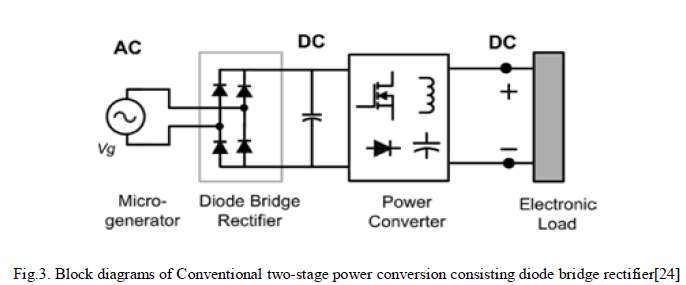 |
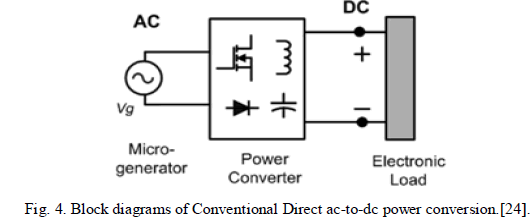 |
| To address the problems of the conventional two-stage converters, direct ac-to-dc converters are proposed [8], [9]. In these converters, bridge rectification is avoided and the microgenerator power is processed only in a single-stage boosttype power converter [Fig.4]. |
| B. H. Stark, et.al [18] examines the design of a circuit and semiconductor devices to convert this energy to a low voltage. Because of the very small charge involved, the effects of leakage and parasitic stored charge are important. Converters for this application using silicon-on-insulator metal–oxide–semiconductor field-effect transistors and insulated gate bipolar transistors are compared using physics-based finite-element simulation. |
| A pulsed-resonant ac–dc converter and an integrated circuit (IC) controller have been designed, fabricated, and tested for harvesting energy from low-voltage, low-power energy transducers with output frequency in the 10-Hz–1-kHz range.A self-powered micro-energy harvester comprising a CMOS IC and an external inductor has been designed, fabricated, and tested by Shengwen Xu et.al.[19]. Energy harvesting for battery charging has been demonstrated using source power between 2W and a few hundred microwatts; source voltage amplitude from 1.2 to 2.4 V; and source frequency from 10 Hz to 1 kHz. Efficiency up to 70% has been measured, although 60% is the average efficiency measured using commercial inductors with 8 mm volumes. |
| P. D. Mitcheson et.al[20].presented circuit topologies for, electromagnetic and electrostatic energy harvesting methods the circuits each allow the effective load on the generator to be varied using switching duty cycles, they also present a convenient mechanism for dynamically optimising the load to extract maximum power under varying source motion. |
| An electromagnetic power generator with a high-performance the feedforward and feedback DC-DC PWM Boost Converter energy harvesting circuit, was designed by Xinping Cao et.al.[21]. The circuitwas implemented on a PCB board first and then on a 0.35 μm CMOS IC chip, has beendesigned and fabricated. By introducing a feedback control into a feed forward DC-DC PWM Boost Converter, the energy harvesting circuit shows high energy conversion efficiency. In this design, the maximum output power of 35 mW has been successfully harvested.T.Painget.al [22] presented an approach and associated circuitry for harvesting near maximum output from low power sources in the 100 μW range for miniature wireless devices. |
| Two power conditioning circuits are designed by Reinhilde D’hulst et.al.[23] – one is a standard buck converter and another one is converter using Synchronous Charge Extraction Circuit(SCHE). The highest efficiency of the buck converter, 67.4%, is obtained using a switching frequency of 0.5 kHz and an inductance value of 68 μH. The duty cycle in the optimal point is 0.056%. The highest efficiency, 61.5%, of the SCHE-converter is reached using an inductance value of 33 μH. The calculated on-time of the switch at this point is 248ns. The efficiency of both converters is calculated for varying inductance, using the optimal load conditions of the bimorph harvesting device as input. An output voltage of 3 V is chosen for both power processing circuits and input power is 0.37μW. |
| S. Dwari et al. [24] presented another one converter topology consists of a boost converterin parallel with a buck–boost converter, which is operated in the positive half cycle and negative half cycle respectively.A self-startup circuit, using a battery only during the beginning of the converter operation is proposed for the energy-harvesting converter. The measured efficiency of the converter is 61%. |
| Gyorgy Det.al.[25] demonstratedsingle-stage boost rectification for electromagnetic energy harvesters down to approximately 100 μW using practical low-power techniques. The circuits exploit the inductance of the generator, and operate without a discrete inductor, which facilitates integration. The circuits demonstrate up to 84.1% harvester utilization at the maximum extractable harvester power of 141 μW, and conversion efficiencies of 73.3% and 59.4% for half- and full-wave operation respectively, neglecting gate drive losses. |
| The converter use the bidirectional current conduction capability of MOSFET to avoid the use of front-end bridge rectifier which operates in discontinuous conduction mode was designed by S. Dwari et. al.[26]. The designed microgenerator that having the coil inductance is sufficiently high to be used for boost conversion apart from EMF induction. Such a set-up makes the system much more efficient and compact. For the case presented here, the mechanical damping is high and cannot be matched by the electrical damping of the converter. Therefore, a simple PI controller was used for voltage regulation. |
| On his [Shuo Cheng et al[27]] circuit employs Voltage Multiplier Usingactive diodes and does not require any external power supply or startup circuitry. The circuit rectifies and boosts input ac voltages in the range of 0.35–2 V and 20–500 Hz to a dc voltage output, that is, approximately 8 times higher than the input amplitude. The circuit can cold start from an input voltage of 0.5 V or higher, providing an output voltage sufficient to charge a 3.7-V lithium ion battery. Once started, the circuit can maintain operation at input voltage amplitudes as low as 0.35 V. Over 80% efficiency is achieved from 20 to 100 Hz, with output power ranging from a few microwatts to 1 mW. |
CONCLUSION |
| This paper has presented the comparative analysis on electromagnetic generator and power processing circuits of energy harvesting. A comparison of the various electromagnetic microgenerator designs has been discussed. The electromagnetic generators can be classified according to their moving element part, coil and magnet shapes, input vibration and or the device volume. A wide variety of spring/mass configurations with various types of material are used in the design of the electromagnetic microgenerator. From this review an efficient electromagnetic microgenerator is to be designed with NdFeB as a magnetic material and a coil with a compact size. |
| In this survey analysed the various converter topologies which avoids the use of bridge rectifiers, and directly converts the ac input to the required dc output. Finally the low voltage energy harvesting power processing circuit, the controller and gate driver circuits require a dual dc supply for their operation, and the startup circuit is used to provide the dc supply. In future the proposed power processing circuit is to be designed with improved efficiency. |
References |
|